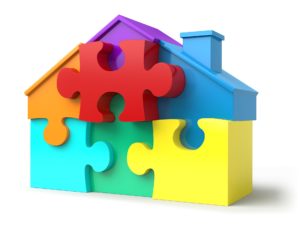Lining up home insurance is one of the first tasks you should do when buying a home. Tackling this task can be daunting, but it’s an important aspect of owning a home. Also, lenders require you to line up insurance during the process of buying a home. Below is helpful information and things to consider.
What exactly is home insurance?
 This type of insurance helps cover the costs associated with accidental damages and loss caused by events such as hail, windstorms, lightning strikes, and fire. Your policy usually covers structural damage, personal property, and personal liability. But the amount of coverage varies depending on the policy you choose.
This type of insurance helps cover the costs associated with accidental damages and loss caused by events such as hail, windstorms, lightning strikes, and fire. Your policy usually covers structural damage, personal property, and personal liability. But the amount of coverage varies depending on the policy you choose.
Homeowners insurance helps provide protection against many major perils, but not all. One major peril it usually doesn’t cover is flooding. Flood insurance is a separate issue and is an additional fee. Also, freestanding structures, such as a detached garage or shed, may also need separate coverage. There are different riders that you may add to your home insurance. Talk with an agent to see what additional coverage might suit your needs.
What factors affect the costs of insurance?
Home insurance is extremely customizable, and thus, the process of figuring out what you want and need can be overwhelming. But a basic rule of thumb is the more coverage you want, the more you’ll pay. How much insurance coverage you purchase will usually determine how much the insurance company will compensate you if your property is damaged. Here are some factors that will affect your rate.
The Level of Coverage You Choose
Here are the three levels of coverage that insurance companies usually offer:
- Actual Cash Value
An actual cash value policy helps cover the cost of what’s been lost, after taking into account depreciation. With this policy, you don’t get back what you paid, dollar for dollar. You get back less. So with this policy, if your she-shed was burned to the ground, you won’t be able to replace it with the exact same one at today’s prices. - Replacement Cost

A replacement cost policy does not account for depreciation, so you may repair/rebuild your home to the original value at today’s prices. - Guaranteed Replacement Cost/Value
This is the ‘Cadillac’ of home insurance policies. This is coverage that is more than your home is worth. So, if your home is destroyed, this policy covers more than it originally cost to build the home. It takes into account inflation and hence usually covers more than your policy limit.
The Risk Involved
The insurance company’s perceived risk of you filing a claim also affects your rate. If you’re one to file many claims, your insurance is more likely going to cost more than someone who doesn’t.
Your policy cost is also affected by the home itself – it’s age, condition, roof type, proximity to the coast, etc. If the home you’re buying is old and has had many claims from previous owners, the risk of the insurance company taking on insuring that home is more than insuring a brand new home. So the cost will be higher. If it has a pool or a trampoline, the cost is usually higher.
The crime rate in a neighborhood can also affect the cost of your home insurance. Whether or not your community is gated can affect the cost of your home insurance. And as you could guess, if your home has a security system, smoke detectors, and carbon monoxide detectors, this could also affect the cost of your insurance.
Home Insurance Deductibles
Just like other insurance types, such as auto and health, home insurance has deductibles. There is an inverse relationship between your annual premium and your deductible. The higher the premium, the lower the deductible. And the lower the premium, the higher the deductible.
Shopping for Home Insurance
When choosing a homeowners insurance company, there are many factors to consider. The obvious one is price, but don’t let this be the only item you consider. Here are a couple of other things to research.
Are they legitimate?
There are a lot of scams these days. So it would be wise to double check that the insurance company is even licensed to conduct business in Texas!
Investigate Consumer Satisfaction
Are customers generally happy or are there are a lot of complaints? Are most customers complaining about the  insurance company not paying claims? Or are most customers complaining about slow response times and it taking forever to be reimbursed? A great indicator of customer satisfaction is the insurance company’s retention rate. If most policyholders renew each year, you might have found a good company.
insurance company not paying claims? Or are most customers complaining about slow response times and it taking forever to be reimbursed? A great indicator of customer satisfaction is the insurance company’s retention rate. If most policyholders renew each year, you might have found a good company.
Some websites track consumer satisfaction and feedback. Consider creating an account with one of the top agencies, like A.M. Best or Moody’s, to investigate ratings for various insurance companies. These agencies sometimes also check the financial health of insurance companies, to determine whether the companies have the ability to pay claims.
What if you’re denied?
Keep in mind that if one insurance company denies you coverage, another company may offer you coverage. So, don’t think it’s the end of the world if you get denied by an insurance company. Insurance companies have varying acceptance standards and many factors go into an approval or denial.
One reason for denial may be that the home has too many past claims attached to it. To find out, ask for a copy of the home’s CLUE report. CLUE stands for Comprehensive Loss Underwriting Exchange. This report shows a property’s claims for the past seven years and could be the reason why an insurance company denies offering you coverage.
Shopping for homeowners insurance is definitely a heavy homework assignment, but it’s an important step in purchasing a home. Shop around to find yourself the best deal for the coverage you desire. For questions and more information, contact the Texas Department of Insurance. Always feel free to contact us at Baker Realty also. We’re happy to help.

